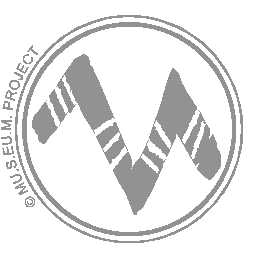|
||||||||||||||||||||||||||||||||
|
|
Museum of: Bucharest | |||||||||||||||||||||||||||||||
| Name of the artefact: Kourotropos | ||||||||||||||||||||||||||||||||
|
Burnt clay figurine representing a woman which is
breast feeding her child |
||||||||||||||||||||||||||||||||
|
WHERE IS IT AND MAIN
CHARACTERISTICS |
STATE |
|||||||||||||||||||||||||||||||
|
Department: |
Archaeology |
Preservation: |
Poor | |||||||||||||||||||||||||||||
|
Inventory number: |
12104 |
Restauration: |
Restored | |||||||||||||||||||||||||||||
|
Name of the artefact: |
Kourotropos |
Completeness: |
Incomplete | |||||||||||||||||||||||||||||
|
Object type: |
Human figurine |
|||||||||||||||||||||||||||||||
|
Material: |
Clay |
|||||||||||||||||||||||||||||||
|
Methof of manufacture: |
Shaping, firing |
|||||||||||||||||||||||||||||||
|
Decoration
type: |
Incision |
|||||||||||||||||||||||||||||||
|
Distinctive mark: |
The statuette is decorated with geometric
incised |
|||||||||||||||||||||||||||||||
|
DIMENSIONS |
PERIOD OF USE |
|||||||||||||||||||||||||||||||
|
Length (mm): |
- |
Epoque: |
Neolithic |
|||||||||||||||||||||||||||||
|
Heigth
(mm): |
125 |
Culture: |
Vinča |
|||||||||||||||||||||||||||||
|
Diameter
(mm): |
- |
Period: |
Late Neolithic |
|||||||||||||||||||||||||||||
|
Width (mm): |
80 |
Face: |
Rast-Vinča B2/C |
|||||||||||||||||||||||||||||
|
Thickness (mm): |
- |
Absolute chronology: |
5000 BC |
|||||||||||||||||||||||||||||
|
Weight
(g): |
- |
|||||||||||||||||||||||||||||||
DISCOVERY |
||||||||||||||||||||||||||||||||
|
Date: |
1943-1950 |
Country: |
Romania |
|||||||||||||||||||||||||||||
|
District: |
Dolj |
Town hall affiliation: |
Rast |
|||||||||||||||||||||||||||||
|
Village: |
Rast |
Discovery findspot: |
Gârla Ţifarului |
|||||||||||||||||||||||||||||
|
Condition of discovery: |
Archaeological excavation |
Discovery type: |
Deposit |
|||||||||||||||||||||||||||||
|
ANALYSES – DETERMINATIONS |
FILLED IN BY |
|||||||||||||||||||||||||||||||
|
Type: |
- |
Name: |
Radian Andreescu, Katia
Moldoveanu |
|||||||||||||||||||||||||||||
|
Laboratory: |
- |
Institution: |
MNIR |
|||||||||||||||||||||||||||||
|
No./Code: |
- |
Date: |
20/09/2005 |
|||||||||||||||||||||||||||||
|
DEEPENINGS |
||||||||||||||||||||||||||||||||
|
Morphology of the object: |
||||||||||||||||||||||||||||||||
|
The statuette, made of dark grey clay, has its head
missing. It has a flat back and prominent buttocks. Two prominences mark
the breasts. On its legs she holds a child with the left hand while the
right hand is placed under the left breast. The missing head of the child
was oriented toward the mother's breast, suggesting that the mother is
nursing the child. The mother's arms are perforated on the elbow and
shoulders zone. |
||||||||||||||||||||||||||||||||
|
Decoration: |
||||||||||||||||||||||||||||||||
|
The statuette is decorated with geometric incised
motifs. |
||||||||||||||||||||||||||||||||
|
Inscription: |
||||||||||||||||||||||||||||||||
|
- |
||||||||||||||||||||||||||||||||
|
Analogies: |
||||||||||||||||||||||||||||||||
|
Even though the motherhood representations are quite
rare, they are spread on a wide area in the whole Neolithic society. The
feminine figurines, more or less realistic modelled, are usually seated
and holding a child in their arms. The child has the head pointed to her
mother’s breast suggesting the act of feeding. Analogies: Sesklo (Greece),
Fafos II, Gradac, Vinča (Vinča culture, Former Yugoslavia), Zengövárkony
(Lengyel culture, Hungary) |
||||||||||||||||||||||||||||||||
|
Interpretation: |
||||||||||||||||||||||||||||||||
|
The attitude in which the statuettes are modelled
suggests a ritual that can be related with motherhood.The act of feeding
the child associated with the maternal devotion impressed people even from
prehistory. The breast feeding gesture can suggest in a symbolic way the
vegetation renewal and life perpetuation through the mediation of the
child. |
||||||||||||||||||||||||||||||||
|
Bibliography: |
||||||||||||||||||||||||||||||||
|
Author: Dumitrescu, Vl Title: Arta preistorică în
România Place: Bucureşti Year: 1974 2. Author: Gimbutas, Marija Title: The
Gods and Goddesses of Old Europe Place: London Year: 1974 3. Author:
Dumitrescu, Vl Title: The Neolithic settlement at Rast Periodical: BAR
International Series Volume: 72 Place: Oxford, UK Year: 1980 4. Author:
Gimbutas, Marija Title: The language of the Goddess Place: San Francisco
Year: 1989 |
||||||||||||||||||||||||||||||||

